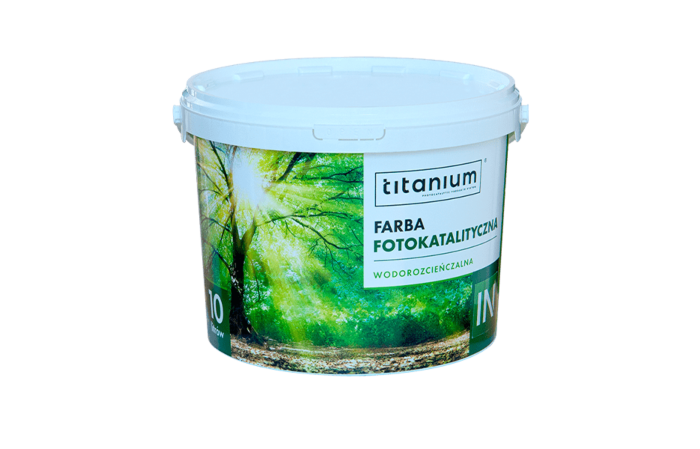TITANIUM IN interior acrylic paint photocatalytic anti-allergic anti-virus I class TITANIUM IN white matte 10 l VIROCIDAL ANTI-SMOG THERMAL INSULATION WASHABLE ACRYLIC PAINT, ANTI-ALLERGIC NANOTECHNOLOGY.
USAGE
It can be used on a variety of building materials, such as: mineral and polymer plasters (e.g. acrylic), concrete, bricks, gypsum, paper wallpapers. It gives the surfaces inside the rooms an aesthetic and durable appearance. A slightly soiled paint surface can be washed with a slightly damp cloth or sponge. It is based on a water polymer dispersion with the addition of pigments, mineral and synthetic fillers and enriching agents. Contains a photoactive catalyst. It is produced in a basic white color, but on request it can be colored with high-quality pigments in a range of pastel colors. Water-thinnable paint intended for painting surfaces of walls and ceilings inside rooms. Creates a wash-resistant, well-covering, deeply matte coating that is permeable to vapors and gases (diffusion, "breathing" of walls). TITANIUM IN is a technologically advanced paint with photocatalytic, thermal insulation and thermoreflective properties. Thanks to the use of a composite of microspheres, the paint has a very high ability to reflect heat radiation - it retains heat in winter and reduces room heating in summer. Two functions have been combined in one paint, photocatalytic and thermo-reflective (thermal insulation).
PHOTOCATALYTIC AND THERMOREFLEXIVE PROPERTIES
The paint contains a composite with photocatalytic and thermoreflective (thermal insulation) properties, which is a combination of relatively large silicate microspheres with a photoactive catalyst. The product is effective in removing urban and industrial gas pollutants such as: tobacco smoke, sulfur dioxide, carbon monoxide (carbon monoxide), nitrogen oxides, aldehyde vapors, alcohols (methanol, ethanol, isopropanol), aromatic and aliphatic hydrocarbons (benzene, toluene, ethylbenzene, xylene, kerosene, gasoline). As a result of the photocatalytic process, taking place in the presence of light and oxygen (contained in the air), atmospheric pollutants, in contact with painted surfaces, are oxidized and transformed into substances that are harmless to health and the environment. The larger the surface is covered with photocatalytic paint, the faster they are removed from the environment. In the presence of the catalyst (contained in the paint), discolorations on the wall surfaces, e.g. nicotine stains, are also cleaned. The phenomenon occurs using direct, reflected, diffused, both solar and artificial light. In the case of insufficient natural lighting, in order to maximize the effect of the paint, it is advisable to install additional lighting. Moisture contained in the air (e.g. in rooms) is enough for the process to run. The composite present in the paint gives the paint the ability to barrier more than 90% of the thermal energy from infrared (thermal, IR) radiation incident on its surface, lowering the heat transfer coefficient and helping to save heat in winter. Studies have confirmed that the paint effectively insulates the walls of buildings, which, covered with it, reflect thermal radiation. This extraordinary property is due to the microspheres thanks to which the paint reacts intelligently to the changing temperature inside and outside the room. Microspheres are small spherical particles with an inert gas inside. This ensures excellent reflection of radiation. Thanks to this, the room keeps warm on cold days and does not heat up on hot days.
SURFACE PREPARATION AND APPLICATION
After mixing, the paint is ready to use, only if it thickens, you can add up to 5% of water. The surface to be painted should be thoroughly cleaned, loose paint flakes removed and degreased. Old coatings of glue and lime paints must be removed. Fresh cement-lime plaster can be painted not earlier than 4 weeks after application. Smooth surfaces should be matted with sandpaper. Spalls and cracks should be filled with FILLER or BIEL-PUTZ putty, larger ones with gypsum. The substrate should be primed with the acrylic agent BIEL-GRUNT or SIL-GRUNT or Universal Primer Paint.








